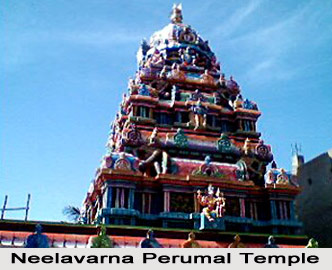 The inscriptions engraved throughout the temple walls points to the traditionality and the antiquity of the temple. These epigraphic evidences not only provide information about the important and ancient inscription of the eighth century A.D. of the Pallava age has been discovered in the Neelavarna Perumal temple, thus revealing that it was constructed during the reign of the Pallava kings who ruled from their capital-city Kanchipuram. The kings of this dynasty were ardent upholders of the Vedic tradition and built many temples in their land. This Pallava inscription has been kept carefully in the front mandapa of the temple and can be viewed by all the devotees visiting this shrine. In ancient Tamil Nadu, the terms mangalam, chaturvedimangalam, agraharam and Nallur were added to the names of the villages, which were peopled by scholars of the Vedas, and thus the name Nanmangalam clearly indicates that this place too was once the hub of religious and educational activity.
The inscriptions engraved throughout the temple walls points to the traditionality and the antiquity of the temple. These epigraphic evidences not only provide information about the important and ancient inscription of the eighth century A.D. of the Pallava age has been discovered in the Neelavarna Perumal temple, thus revealing that it was constructed during the reign of the Pallava kings who ruled from their capital-city Kanchipuram. The kings of this dynasty were ardent upholders of the Vedic tradition and built many temples in their land. This Pallava inscription has been kept carefully in the front mandapa of the temple and can be viewed by all the devotees visiting this shrine. In ancient Tamil Nadu, the terms mangalam, chaturvedimangalam, agraharam and Nallur were added to the names of the villages, which were peopled by scholars of the Vedas, and thus the name Nanmangalam clearly indicates that this place too was once the hub of religious and educational activity.
The consecration or Samprokshanam of the Neelavarna Perumal temple, is consecrated as a prarthana Sthala and abhimana Sthala of Tiruneermalai Neervanna Perumal (one of the 108 Divya Desams), was performed on 30th April, 2006. This temple is located about half a kilometer to the west from the Kovilambakkam bus-stand (near Tambaram) in the St. Thomas Mount-Medavakkam junction road, Tambarai. Once upon a time considered to be a place very far from the centre of the city, this is now very much part of Chennai. It is hoped that more people will visit this small but ancient temple, which was once in a dilapidated condition but has now, with much devotion and dedication, been restored and renovated by the temple authorities.





















